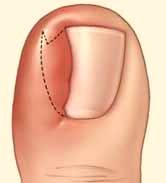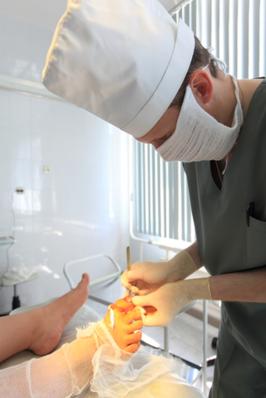|
Toenail removal
Toenail removal is a pretty drastic step to take and involves surgery which can be painful, however anesthetic is such as to make the surgery not too bad an experience
The result being that great care must be taken with that particular toe after surgery in order for the new toenail to grow back, straight and in good condition. The post opperative condition can take as long as one year to completely renew and cover the toenail plate bed. It is for these reasons that care must be taken in making the right decision to have the surgery at all.
Reasons for Toenail removal
Some of the more common reasons for the removal of a toenail are;
can be caused by a severe blow to the toe or the toenail causing great
toe pain the toe itself may then turn blue and this usually results in a black toenail which eventually, after several weeks, will drop of and a new nail will begin to form. The nail can be infected by a nail fungus which is a bacteria that grows and multiplied between the layers of the nail. In some cases, if it is a bad infection, a Chiropodist or a Podiatrist may well advise on toenail removal by surgery to prevent infection of other toenails. If left untreated an Ingrown toenail 
can become severe enough to warrant toenail surgery and the partial or total toenail removal. This will not only alleviate the pain but will also allow the new nail which will form in its place, to be
trained to grow straight
Corns that grow under the toenail are called 'Sub ungal' corns These can be particularly painful and must be dealt with by a professional. Delicate attention is required and the pain can be relieved by drilling a hole in the nail directly above the corn. This will allow the Podiatrist to work on the corn and relieve the pain. Or another way would be to remove the toenail completly. Read the page on
Ingrown toenail treatment
Toenail RemovalThe surgical removal of the toenail is performed using a local anesthetic and is relatively painless.
The aftercare of the toe is important as it must be kept free from any form of infection. Regular check ups with the Chiropodist will ensure the new forming and growing nail will grow straight and infection free.
Many top athletes will have experienced the loss of a toenail due to 'toenail trauma'.
The sustained hammering effect upon the toenail stride after stride can damage the small blood vessels under the nail of the toe. This allows the blood to leak from these blood vessels and lie between the nail bed and the nail. Making it look blue, or black.
The training shoes should not be too tight around the toes. The socks should not be too thick or made from a synthetic material. The friction and heat build up between the toenail and the tissue around it can be quite substantial if the above two points are not right. As for the damaged toenail, the nail will slowly come detached, separate from the nail bed and root and fall off. This allows the new forming nail to grow, it will take time and some TLC but somewhere around 9 months to 1 year the new nail will have formed completely. The correct cutting of the new nail, correct footwear to ensure unhindered growth and other tips can be found in the Top Tips section of
Back to Top of page
|
| Turn your knowledge your hobby or passion into your own business |
S.B.I helps you to take your hobby your knowledge or passion and turn it into an enjoyable and profitable Home Business.
With amazingly helpful forums the energy from fellow S.B.I ers drives you on to success, click on the S.B.I. box above to take a look.
This just could be the break you have been looking for.
In case you help
ask a professional live
Other related pages
Ingrown Toenail Treatment
Toenail Removal
Toe Pain
Podiatrist
Natural Cure
My Picks
Ingrown Toenail products
Spin the ferris wheel by using the arrows and select the product of your choice
H2O Skincare, click on the picture to see the product range.
Advertise with us
If you have a good product to advertise that is related to these pages then please Contact us.
We have a growing following and pride ourselves in providing the best advice and products for Toenail Care and Healthy Feet.
Sell you photos to Dreamstime, a photo publishing site. A click on the photo will take you there.
Poppy fields in springtime
A click on the photo will take you to the Natural Cure page.





